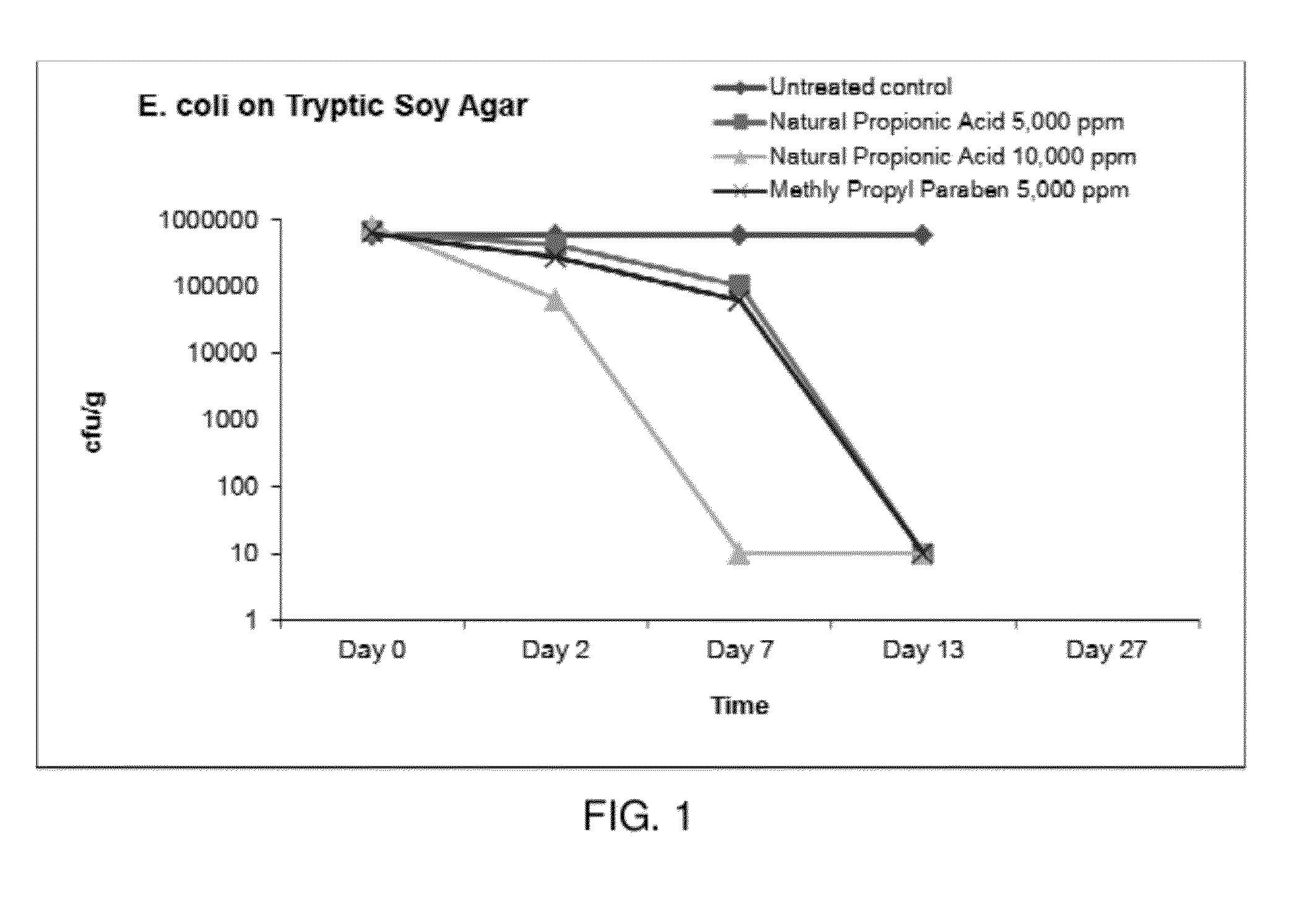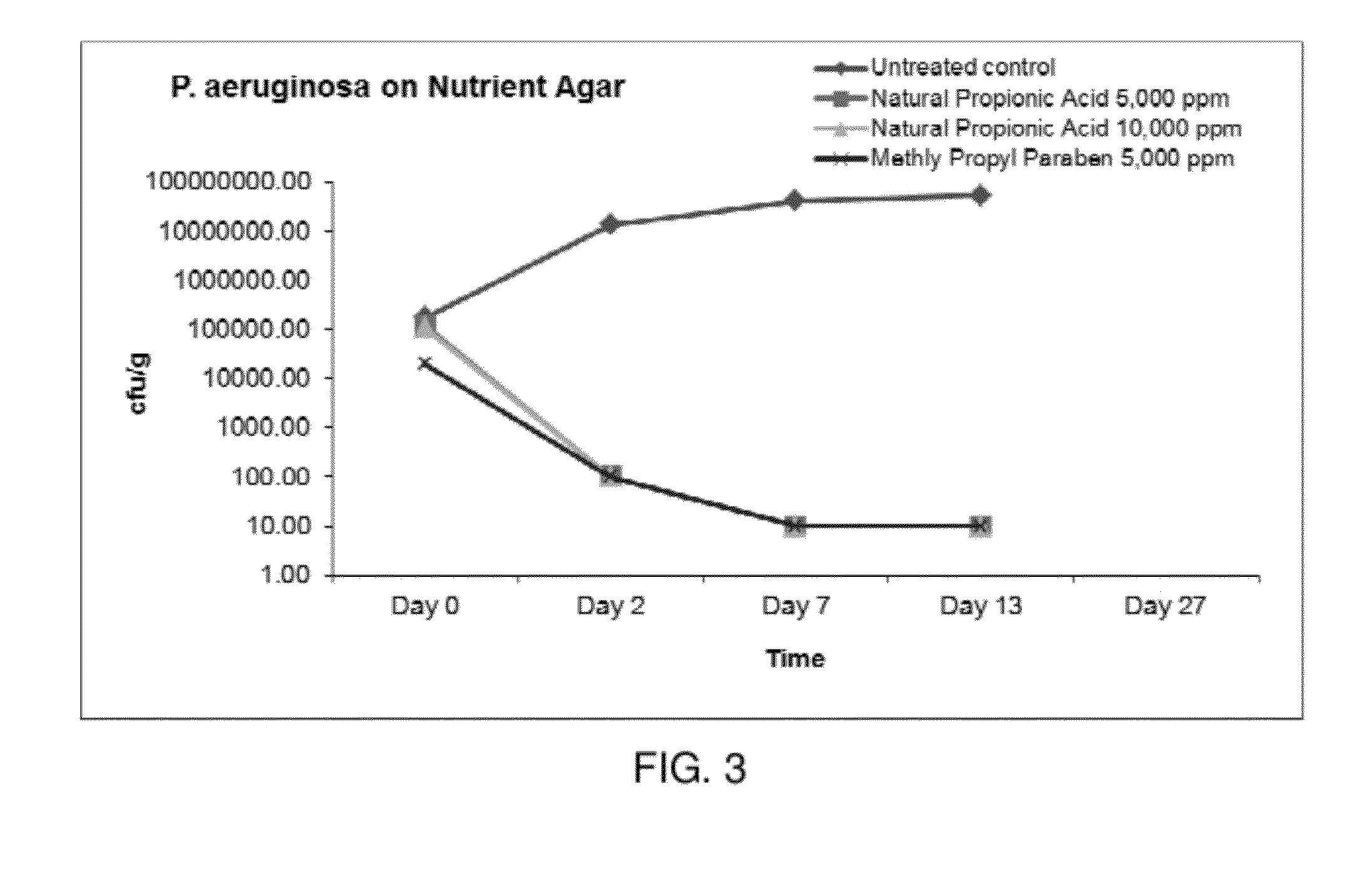Use of Propionic Acid as an Antimicrobial
a technology of propionic acid and antimicrobial properties, applied in the field of fungicides, can solve the problems of single preservatives that achieve the desired broad spectrum antimicrobial properties, and are not anticipated to have strong antimicrobial effects
- Summary
- Abstract
- Description
- Claims
- Application Information
AI Technical Summary
Problems solved by technology
Method used
Image
Examples
example 1
Materials and Methods
[0014]The pathogens used in the tests were obtained from commercial sources. The pathogens were harvested and adjusted to 107 CFU / mL.
[0015]The personal care product used in the tests was a skin cream formulation made with natural ingredients. The ingredients in the cream (100 g) were 18 g jojoba oil (Sigma-Aldrich 59980 jojoba oil from Simmondsia chinesis), 6 g olive oil (Sigma-Aldrich O1514 olive oil), 3 g safflower oil (Sigma-Aldrich 5828 safflower oil from Cartanus linctorius seed), 15 g sunflower oil, 5 g emulsifying wax (Spectrum W1026), and 0.05 g BHT (500 ppm) in the oil phase and 1 g xanthan gum (Sigma-Aldrich G1253 xanthan gum from Xanthomonas campestris), MycoCURB® (Kemin Industries, Inc., Des Moines, Iowa), and water in the water phase. The MycoCURB was dissolved in water in a beaker and adjusted to pH 4.50 using 10% HCl. The xanthan gum was added to the beaker. The water phase and oil phase were heated separately to 80° C. in a water bath. The water ...
example 2
Materials and Methods
[0023]MicroCurb, containing 33% propionic acid, was applied to treatments in first replication, and MicroCurb containing 41.8% propionic acid, was applied to treatments in second replication. The treatments were standardized to contain 0.5% and 1.0% natural propionic acid (NPA) in both replications.
[0024]Cream Formulation.
[0025]Aseptic techniques were followed in the preparation of the treatments by using equipment and conducting the cream formulations in a laminar flow hood. Methyl and propyl paraben were obtained from internal stocks. Jojoba oil, olive oil, safflower oil, sunflower oil, emulsifying wax, and xanthan gum were purchased from Sigma-Aldrich (St. Louis, Mo.). The recipe and procedure of making the cream formulations were as follows:
TABLE 1Amount of ingredients used to prepare 100 g of cream with differentantimicrobials (in grams) for the first replicationNeg-0.5% Methyl +ative0.5% PropylIngredientsControl0.5% NPA1% NPAParabenOil PhaseJojoba Oil18181...
example 3
Materials and Methods
[0040]Preparation of MicroCurb™.
[0041]MicroCurb, containing 33% propionic acid, was applied to the treatments in first replication, and MicroCurb containing 41.8% propionic acid, was applied to the treatments in second replication. The treatments were standardized to contain 0.5% and 1.0% natural propionic acid (NPA) in both replications. An alternative natural source of carnosic acid was added to formulations to determine if it had any activity.
[0042]Cream Formulation.
[0043]Aseptic techniques were followed in the preparation of the treatments by using equipment and conducting the cream formulations in a laminar flow hood. Rosemary extracts (RE) are known in the industry as sources of carnosic acid. Rosamox™ Liquid (Kemin Industries, Inc., Des Moines, Iowa), is an RE which is a formulation of sunflower (Helianthus annuus) oil and an extract of rosemary (Rosmarinus officinalis) which contains 4.51% carnosic acid, and was obtained internally. Methyl and propyl par...
PUM
| Property | Measurement | Unit |
|---|---|---|
| Fraction | aaaaa | aaaaa |
| Fraction | aaaaa | aaaaa |
| Time | aaaaa | aaaaa |
Abstract
Description
Claims
Application Information
 Login to View More
Login to View More - R&D
- Intellectual Property
- Life Sciences
- Materials
- Tech Scout
- Unparalleled Data Quality
- Higher Quality Content
- 60% Fewer Hallucinations
Browse by: Latest US Patents, China's latest patents, Technical Efficacy Thesaurus, Application Domain, Technology Topic, Popular Technical Reports.
© 2025 PatSnap. All rights reserved.Legal|Privacy policy|Modern Slavery Act Transparency Statement|Sitemap|About US| Contact US: help@patsnap.com



